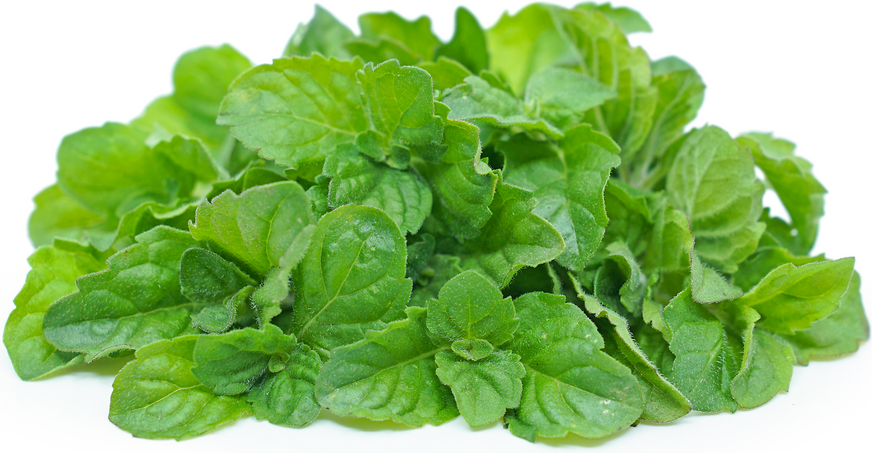


Lime Mint
Estimated Inventory, 4 oz : 0
This item was last sold on : 01/27/25
| Fresh Origins | Homepage |
Description/Taste
Lime mint is a variety of mint known for its strong, citrus scent. It grows on a green plant that can reach up to 40 centimeters in height. Lime mint leaves are round and oval-shaped with slightly toothed edges. They have a lime green hue with occasional hints of purple along their leaf spines and stems. The leaves have a soft, fuzzy texture due to the small white hairs that cover their surface. When consumed raw, they have a crisp and tender texture that's slightly chewy and crunchy, similar to basil leaves. Lime mint seeds emerge from the plant's blooming flowers. The plant has a traditional minty aroma with notes of lime. Aromatic oils are released when the Lime mint leaves are crushed. It has a bright, zesty, lime flavor that’s most vibrant when eaten fresh.
Seasons/Availability
Lime mint is typically available year-round.
Current Facts
The botanical name for Lime mint is Mentha x piperita subsp. citrata and it is a member of the Lamiaceae or Labiatae family. Lime mint is a hybrid of common mint, an aromatic herb that's almost exclusively perennial rather than annual. Like many varieties of mint, Lime mint is often used for pest control in gardens due to its ability to attract beneficial insects like butterflies and bees and detract harmful insects like aphids, fleas, and ants. Since mint originated, many hybrids like Lime mint have been created to mimic the aromas of other fruits. There are Strawberry, Banana, Orange, Pineapple, and Lemon mint varieties, each offering a nuanced taste and fragrance. These distinctive flavors excel in teas and essential oils, where their subtle differences can be appreciated.
Nutritional Value
Lime mint is a source of antioxidants like rosmarinic acid, which may be able to reduce symptoms of allergies when consumed in the form of mint extract oils and ointments. Lime mint contains anti-inflammatory compounds, which may alleviate conditions like asthma, arthritis, and inflammatory bowel disease as well as reduce inflammation in blood vessels, potentially lowering the risk of heart disease. The oil extract from mint has been used to treat digestive issues, headaches, respiratory problems, muscular pain, chest infections, decongestion, and skin conditions like itching and rashes. Mint tea may be used to help combat the common cold. The cooling sensation of mint leaves like Lime mint can be applied to the skin to ease burns. The medicinal use of mint can be traced back to ancient times. Pliny, a philosopher and botanist from ancient Rome, reportedly told scholars that they should wear crowns of mint to increase concentration and clear thinking.
Applications
Lime mint can be used fresh, dried, or crystalized in sugar. It can be paired in recipes that are both sweet and savory. Lime mint can be muddled and used to add a citrusy tang to cocktails, tea, lemonade, marinade, and salad dressing. It can be used as either a topping or flavoring for desserts like sorbet, ice cream, chocolate mousse, custard, cake, and pastries. Lime mint can be sliced up and tossed on top of salads, fruit bowls, soups, potato salads, and grilled or roasted meat dishes. It can be used when preparing sauces or rubs for seafood recipes. Lime mint can be paired with other aromatic herbs in sauces like pesto or mint chutney. It can be added to frozen treats like ice cubes and popsicles. Lime mint is complemented by the flavors of chicken, lemon, basil, potatoes, peas, lamb, vinegar, coconut, cauliflower, avocado, watermelon, burrata cheese, chocolate, ricotta, salmon, rhubarb, blackberry, orange, raspberry, strawberry, lychee, fig, grapefruit, apricot, cumin, bay leaves, paprika, rosemary, sage, pomegranate, and thyme. Lime mint should be stored in the refrigerator where it can last up to 3 weeks.
Ethnic/Cultural Info
Minthe is another word for mint and is also the name of a nymph who was a love interest of Hades, the Greek god of the Underworld. Hades first love, Persephone, was so jealous of Minthe that she transformed the nymph into a plant to be trampled on by mortals, hypothetically explaining the abundance of wild-growing mint bushes today. Both the Ancient Greeks and Romans used mint as a perfume, flavoring for sauces, and table decor. The Ancient Egyptians were known to suffer from poor nutrition, as their diets were low in essential nutrients. They used stone to grind flour, which left sand in their food and caused their teeth to be worn down and prone to infection. The Ancient Egyptians are said to be the inventors of the breath mint as they were the first to use this herb as a cure for bad dental health.
Geography/History
Lime mint is a variety of mint, an herb that originated in the Mediterranean. The mint plant has been naturalized in temperate regions around the world. Mint prefers full sun and can adapt to a variety of soil types. Though wild mint can grow along stream banks and wastelands, the lime variety does not grow in the wild since it is a cultivated, hybrid variety. It is typically grown in home gardens or produced commercially. The mint herb started to spread worldwide when it was brought from the Mediterranean to the British, who then brought mint to America when pilgrims came over to settle in what is now the Northeast of the United States. Varieties like Lime mint have surged in popularity partly due to companies like Fresh Origins® Farms, a prominent supplier based in Northern San Diego County that produces naturally grown microgreens, edible flowers, and petite greens. Fresh Origins® offers Mint Lime Tops alongside other mint varieties like Spearmint, Apple, Banana, and Chocolate, available through select distribution partners across the United States and Canada. Lime mint can also found in specialty stores, farmers' markets, or grown from seeds in home gardens.
Podcast




 Learn More...
Learn More...
